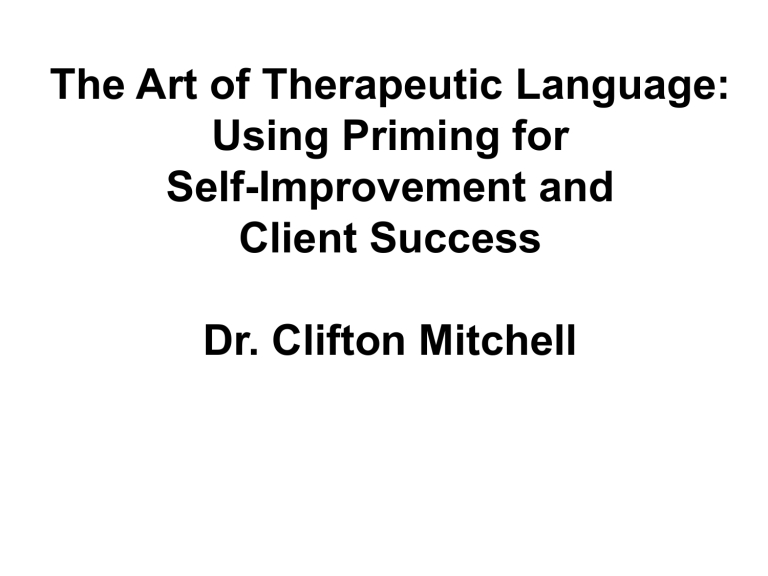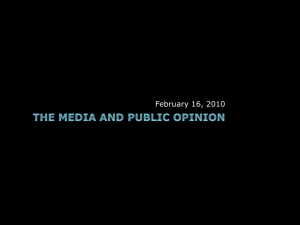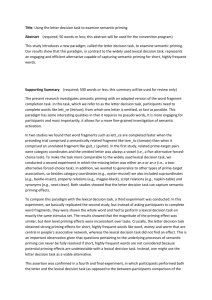Deficit - Clifton Mitchell

The Art of Therapeutic Language:
Using Priming for
Self-Improvement and
Client Success
Dr. Clifton Mitchell
Brain most complex organ in the universe
100,000,000,000 nerve cells
(100 billion)
1,000,000,000,000 glial cells
(trillions)
Each cell has 20,000 connections to other cells
1,000,000,000,000,000 connections
(quadrillion)
Processes 400,000,000,000
(400 billion) bits of info per second
You are only aware of about 2000 bits of info being processed per second
Daniel Amen
The mind move you and your listener in the direction of the
dominant thought, regardless
of whether it is stated in the positive or the negative.
I shed pounds daily for no apparent reason.
Priming refers to a increased sensitivity to certain stimuli due to prior experience.
Priming occurs when an earlier stimulus influences response to a later stimulus.
Priming occurs at the unconscious level.
Subjects primed with words like
“polite” “considerate” “respect” were less likely to interrupt than subjects primed with words like
“rude” “obnoxious” “impolite”
Subjects primed with words like
“old” “Florida” “wrinkles”
“bingo” etc.
performed worse on memory tests than subjects primed with neutral words
Conscious
The Results of Priming
“Elephant”
Gray Large
Elephant
Tusk Tarzan
Jungle
Trunk
Subconscious
Unconscious
Gray
Large
Tusk
Tarzan
Jungle
Trunk
We are controlled by an unconscious behavioral guidance system more than we think. And we are unaware of it.
Once covertly activated, unconscious goals are more powerful or just as powerful as conscious goals.
Goals do not require an act of will to be acquired.
What Does This Mean for the Therapeutic Dialogue?
1. Remember you are constantly priming your clients.
What Does This Mean for the Therapeutic Dialogue?
1. Remember you are constantly priming your clients.
2. Consistently state the positive opposite of client’s negative framing of problems.
What Does This Mean for the Therapeutic Dialogue?
1. Remember you are constantly priming your clients.
2. Consistently state the positive opposite of client’s negative framing of problems.
3. Use high level empathic responses that include deficit statements.
Empathic + …and what you're looking for… + Deficit
Statement …and what you need…
(include …and what you're searching for… content and feeling)
…and what you want is…
…and what you desire is…
…and what you wish is…
Deficit = what client is seeking worded in the positive
Deficit = priming the client to a future goal/state
Deficit = a potentially new dominant thought
What Does This Mean for the Therapeutic Dialogue?
1. Remember you are constantly priming your clients.
2. Consistently state the positive opposite of client’s negative framing of problems.
3. Use high level empathic responses that include deficit statements.
4. Use embedded suggestions/commands in your dialogue.
What Does This Mean for the Therapeutic Dialogue?
1. Remember you are constantly priming your clients.
2. Consistently state the positive opposite of client’s negative framing of problems.
3. Use high level empathic responses that include deficit statements.
4. Use embedded suggestions/commands in your dialogue.
5. Carefully observe client reactions when prime clients.
What Does This Mean for the Therapeutic Dialogue?
1. Remember you are constantly priming your clients.
2. Consistently state the positive opposite of client’s negative framing of problems.
3. Use high level empathic responses that include deficit statements.
4. Use embedded suggestions/commands in your dialogue.
5. Carefully observe client reactions when you prime clients.
6. Remember that your job is to plant seeds. Talk to the subconscious.
“Men must be taught as if you taught them not,
And things unknown proposed as things forgot.”
Alexander Pope
English Poet
(1688-1744)





![This article was downloaded by: [Lalin Anik] Publisher: Psychology Press](http://s2.studylib.net/store/data/010423236_1-bfb4c1f538987af6063cda3b7e59e2cc-300x300.png)